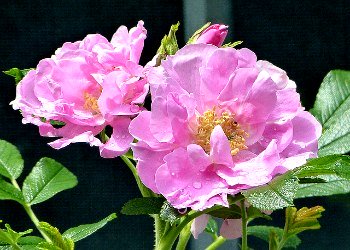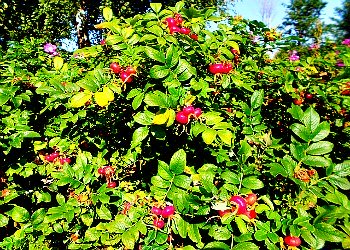Rugosa Rose Bushes
Rugosa rose bushes dislike being pruned and are allergic to chemical fungicides-sprays. They may even drop their leaves
Photo courtesy of Nan

Starting with organic gardening as well as with an easy rose gardening experience, I would recommend trying the Rosa Rugosa.
They are winter hardy, healthy and sturdy shrubs and almost all varieties are fragrant. Rugosas are identified by their bright green and wrinkled (rugose) foliage, which is heavily textured with deep veining.
Personally, I am upset when I spot powdery mildew, rust, or any other disease on my roses. That never happened to the Rugosa varieties. They are extremely resistant against almost all ailments that normally effect roses.
I love it when the foliage of the roses turn into yellow, red brown or any combination of colors in fall-very uncommon among the big roses family.
Healthy Hips From Rugosa Roses
Photo courtesy of Alexey K

While many roses cannot set hips, Rugosas produce large, colorful and healthy rose fruits.
If you like hips, be sure to stop deadheading roses in late summer to let the hips form in fall. Combined with the colorful fall-foliage of these roses, they will form a beautiful display.
Rose hips are used to make tea, jam and are used for many other culinary purposes.
I will talk about what we can produce with rose fruits in another
chapter of my website, but it is true that these rose fruits are an excellent
source of vitamin C and in my opinion, the taste is very delicious too.
Rugosas For Exposed Situations
Where summers are more often cool rather than warm and sunny, you better avoid roses prone to diseases. If the soil is sandy, like in gardens by the coast and the situation is windy, Rugosas would be a perfect choice.
Their tolerance for salt helps them to do well close to streets, where they will get a dose of road salt in winter.
Their winter hardiness made them popular among gardeners in cold areas. They will grow in almost all American climate zones and are hardy to zones 3 and 4.
All in all, a perfect rose for beginners and for an easy rose gardening experience.
Care For Rugosas
I already praised that a Rugosa can be grown almost everywhere. Anyway, left alone, like every plant a Rugosa will not develop as expected.
Planting, Growing and Fertilizing a Rosa Rugosa
To care for Rugosas is easy, that is why I like them. They do not need particular soil conditions, but as every other rose, they will need a sunny site in the garden with about 6 hours of sun or more.
Rugosas are allergic to spraying and normally they will not need it. They could even drop their foliage when treated with chemical-fungicides.
Regular fertilizing is not required for these shrubs. Applying some organic fertilizers would be great, but not necessary. These roses will show their blooms even when you do not feed them for several seasons.
Pruning a Rugosa Rose
These plants normally do not need pruning. The only reason to prune them is to keep your garden neat and clean. Deadheading in summer will be ok, but to get plenty of hips stop deadheading them in late summer.
As for every other rose variety, it is good practice to remove dead and damaged wood every year, usually early spring.
I would advice to sometimes remove older canes to prevent the roses to become invasive and overcrowded.
To keep them smaller you can prune them every year like other rose bushes, but to get best results just leave them alone or do minimal pruning work.
Rose Gardening › Shrub Roses › Rugosa Rose
Rose Gardening › Old Roses › Rugosa Rose






New! Comments
Have your say about what you just read! Leave me a comment in the box below.